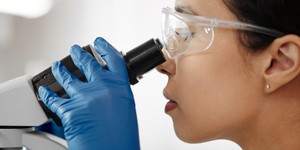Log In
Summary
Areas of Science
Difficulty
Time Required
Average (6-10 days)
Prerequisites
Knowledge about growing and testing bacteria
Material Availability
Specialty items, like bacteria and the media to grow them on, can be ordered from online vendors such as Carolina Biological Supply Company.
Cost
Low ($20 - $50)
Safety
Follow all safety warnings printed on the cleaning solutions you are using. Read the Microorganisms Safety Guide before starting any experiments. Adult supervision is recommended. SRC approval may be necessary.
*Note:
For this science project you will need to develop your own experimental procedure. Use the information in the summary tab as a starting place. If you would like to discuss your ideas or need help troubleshooting, use the Ask An Expert forum. Our Experts won't do the work for you, but they will make suggestions and offer guidance if you come to them with specific questions.
If you want a Project Idea with full instructions, please pick one without an asterisk (*) at the end of the title.
If you want a Project Idea with full instructions, please pick one without an asterisk (*) at the end of the title.
Abstract
Disinfectants are products that kill harmful bacteria that inhabit surfaces. Disinfectants can be in household and personal cleaning products. Which products work best? Compare different household cleaning products, like bleach or Lysol, to see which ones kill the most bacteria. Compare different brands of antibacterial hand soap or dish soap to see which brand is the most effective. How do hand sanitizers work? Compare rub-on hand sanitizers to see if they work better than alcohol, or compare to old fashioned soap and water (Pittis, 2000).Bibliography
Pittis, M. (2000). Which Household Cleaners or Soaps Work Best Against Bacteria? Retrieved May 1, 2006, from http://www.scienceteacherprogram.org/biology/Pittis00.htmlAsk an Expert
Do you have specific questions about your science project? Our team of volunteer scientists can help. Our Experts won't do the work for you, but they will make suggestions, offer guidance, and help you troubleshoot.
Global Connections
The United Nations Sustainable Development Goals (UNSDGs) are a blueprint to achieve a better and more sustainable future for all.
This project explores topics key to Good Health and Well-Being: Ensure healthy lives and promote well-being for all at all ages.
Careers
If you like this project, you might enjoy exploring these related careers:
Career Profile
Microorganisms (bacteria, viruses, algae, and fungi) are the most common life-forms on Earth. They help us digest nutrients; make foods like yogurt, bread, and olives; and create antibiotics. Some microbes also cause diseases. Microbiologists study the growth, structure, development, and general characteristics of microorganisms to promote health, industry, and a basic understanding of cellular functions.
Read more
Career Profile
Think of all the jobs in the world that involve machinery, chemicals, toxins, radiation, loud noise, or travel to places above or below Earth's surface—all of these jobs carry an element of risk to the workers. Industrial health and safety engineers work to minimize this risk. They inspect work sites and help workers and companies understand and comply with safety laws. They use their knowledge of mechanical processes, chemistry, and human psychology and performance to anticipate…
Read more
Career Profile
Many people work in environments that have obvious potential dangers, like collapses in mines, chemicals in laboratories, or machinery in factories, but there can be hazards in almost any job, like repetitive stress injuries from constant computer use or from scanning groceries. Occupational health and safety specialists identify potential hazards in a job, and then figure out ways to reduce the risks of accidents or injuries to workers or to the public. They also investigate accidents when…
Read more
Related Links
Cite This Page
General citation information is provided here. Be sure to check the formatting, including capitalization, for the method you are using and update your citation, as needed.MLA Style
Science Buddies Staff.
"Disinfectants." Science Buddies,
20 Nov. 2020,
https://www.sciencebuddies.org/science-fair-projects/project-ideas/MicroBio_p020/microbiology/disinfectants?class=AQXQJu9S4hM7BOo8T4e5m-xsTlPvc7vPQfXr2unuUJ9hEhH0pf01D5q5ctgclwZO9EJTwcVhwxHGSa87HFqTz0ZJFQbLAa3Up-EkvgSmS9zM4Q.
Accessed 25 Apr. 2024.
APA Style
Science Buddies Staff.
(2020, November 20).
Disinfectants.
Retrieved from
https://www.sciencebuddies.org/science-fair-projects/project-ideas/MicroBio_p020/microbiology/disinfectants?class=AQXQJu9S4hM7BOo8T4e5m-xsTlPvc7vPQfXr2unuUJ9hEhH0pf01D5q5ctgclwZO9EJTwcVhwxHGSa87HFqTz0ZJFQbLAa3Up-EkvgSmS9zM4Q
Last edit date: 2020-11-20
Explore Our Science Videos
Turn Milk into Plastic! Lesson Plan Introduction
Build a Solar-Powered Car for the Junior Solar Sprint
Video: Winding Coil










